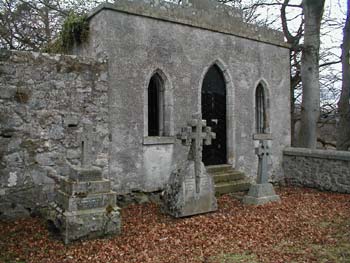On Saturday September 16th 1939 he met with a motorcycle
accident while returning from the nearby town of Bellingham.
Captain Gilbert Chaldecott, Adjutant, Royal Artillery, advised
the Newcastle Coroner that Charles left the camp around 11.30am
and was returning there when the accident happened. It was
said locally in Kennethmont that he was returning from visiting
a Bank and this may have indeed been the reason for his short
visit to the town. It remains unclear whether he was on personal
or military business at the time.
A witness, William Beattie, Postman was returning to Bellingham
on his bicycle when he met a motorcycle near the Sandysyke
junction which he states was travelling North on the Bellingham
- Otterburn road at moderate speed on the correct side of
the road. Hearing a noise after he passed which sounded as
if part of the machine was touching the road Beattie turned
round and saw, about 15 yards from him, the rear of the machine
appear to lift and the officer being thrown against a stone
roadside wall. He went back and found Charlie lying on the
grass verge against the wall. He was unconscious and bleeding
slightly from the left ear. He rendered such first aid as
he could before telephoning for a doctor. Dr Rochester of
Bellingham attended the scene.
Police Sgt James Stoker of Bellingham arrived around mid day
and found Charlie lying on the grass being attended by Dr
Rochester. He examined the Norton motorcycle, number PMD 978,
and found the headlamp broken and the front foot rest and
number plate bent. He states the engine was in good running
order and the brakes were good.
He further states that Charles was wearing a heavy Mackintosh
and that it's left hand bottom front corner was very badly
torn. He came to the conclusion that the coat had caught in
the rear wheel, locked it, caused the machine to overturn,
skid diagonally across the road and crash into the stone wall.

Sgt Stoker's drawing of the accident scene.
Click to view larger version, slow download (60k)
Charles, accompanied by Captain Chaldecott, was taken
to The Royal Victoria Hospital, Newcastle in an Army wagon
and admitted at 3.35pm. The doctors report to the Coroner
states that he had no gross external injuries but some bleeding
from the left ear and that this and his general condition
indicated a skull fracture and brain laceration. He writes
that a motor accident would have caused the injuries he was
suffering from.
The Laird of Leith Hall died of his injuries without regaining
consciousness at 4.05pm.
The funeral took place on Wednesday 27th September. A
very large gathering attended the service at Leith Hall. His
coffin, covered by a Leith tartan cloth and a Union flag,
was carried to the churchyard on a horse drawn cart, the wreaths
and tributes completely covering a second cart. Mrs Leith-Hay
led the sad procession of mourners following the coffin the
two miles to the churchyard. Large numbers of local people
lined the road through Kirkhill. This was to be her second
such journey in the space of four months, she and Charlie,
having led the mourners at the funeral of her husband in May.
He did not have a Military Funeral, the graveside service
was carried out by the parish minister Rev RGB Miller. He
was laid to rest in the family burial vault within the walls
of the old kirk of Kinnethmont
Charles was the 23rd Chief of the House of Leith and last
Laird of Leith Hall for only a few months. On his untimely
death the main family line of Leith Hall was ended forever.
Following the tragedy Mrs Leith Hay decided to keep Leith
Hall and it's Leith-Hay connection alive by passing the House
to The National Trust for Scotland. This she did in 1948.
She continued to live at Leith Hall until her death in 1965.

The Leith-Hay family burial ground is contained within
the walls of the old Kirk of Kinnethmont. The Kirk ceased
to be used as a place of worship when the new church was built
opposite the school in 1812.
The centre memorial (below left) incorporating a cross made
of three individual crosses, taken from the Leith coat of
arms, bears the details of Charles and his parents. The one
to the right, in the form of a Celtic cross, (below right)
is a memorial to his sisters Louisa and Bridget Anne who died
in infancy.